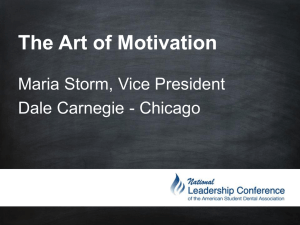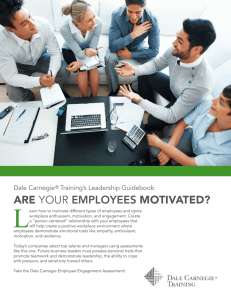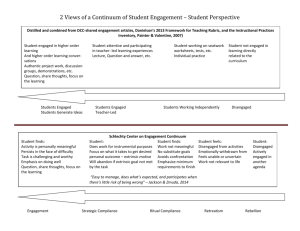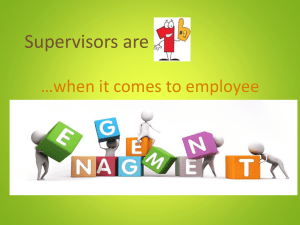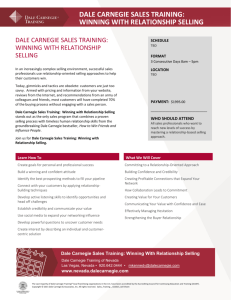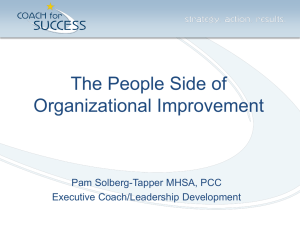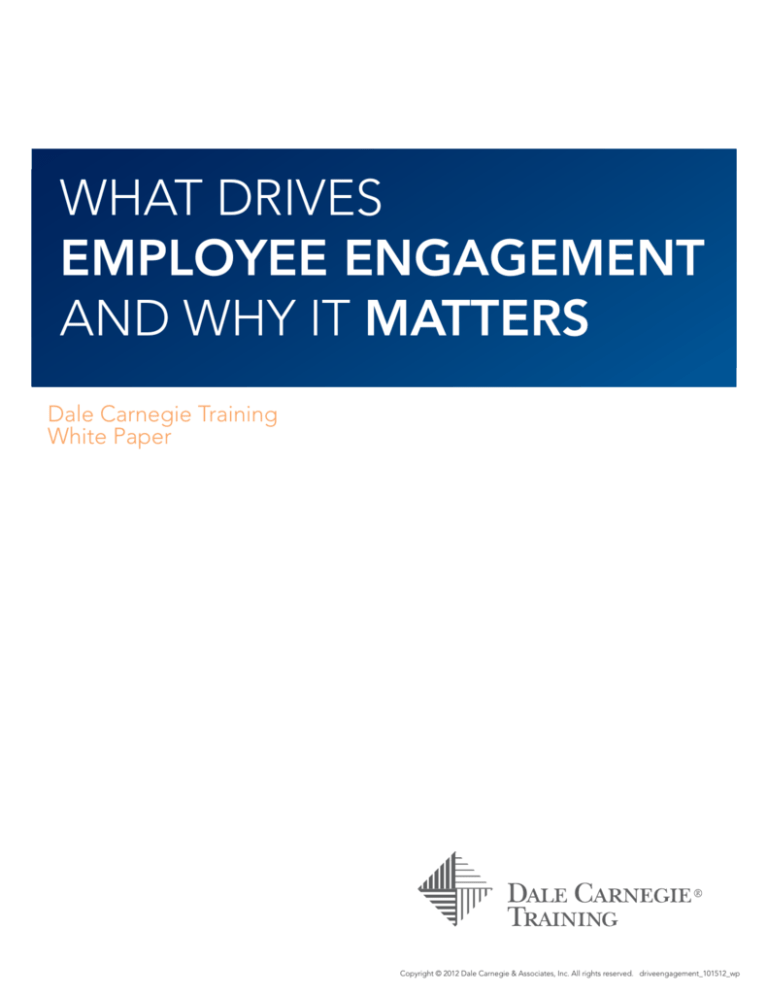
WHAT DRIVES
EMPLOYEE ENGAGEMENT
AND WHY IT MATTERS
Dale Carnegie Training
White Paper
Copyright © 2012 Dale Carnegie & Associates, Inc. All rights reserved. driveengagement_101512_wp
WHAT DRIVES EMPLOYEE ENGAGEMENT AND WHY IT MATTERS
•
DALE CARNEGIE TRAINING WHITE PAPER
THE IMPORTANCE OF PEOPLE
What makes one company more successful than another? Better products, services,
strategies, technologies or, perhaps, a better cost structure? Certainly, all of these
contribute to superior performance, but all of them can be copied over time. The
one thing that creates sustainable competitive advantage – and therefore ROI,
company value and long-term strength – is the workforce, the people who are
the company. And when it comes to people, research has shown, time and again,
that employees who are engaged significantly outperform work groups that are
not engaged. In the fight for competitive advantage where employees are the
differentiator, engaged employees are the ultimate goal.
While there are many research studies that point to the percentage of engaged and
disengaged employees, few studies have looked at what really drives employee
engagement. Dale Carnegie teamed with MSW Research to study the functional and
emotional elements that affect employee engagement. A national representative
sample of 1,500 employees was surveyed, which revealed that although there are
many factors that impact employee engagement, there are three key drivers:
•Relationship with immediate supervisor
•Belief in senior leadership
•Pride in working for the company
Employees said that it is the personal relationship with their immediate supervisor
that is the key. The attitude and actions of the immediate supervisor can enhance
employee engagement or can create an atmosphere where an employee becomes
disengaged. In addition, employees said that believing in the ability of senior
leadership to take their input, lead the company in the right direction and openly
communicate the state of the organization is key in driving engagement. Other
factors that drive engagement are that employees are treated with respect, that their
personal values are reflected and that the organization cares about how they feel.
2
WHAT DRIVES EMPLOYEE ENGAGEMENT AND WHY IT MATTERS
•
DALE CARNEGIE TRAINING WHITE PAPER
SOME BASIC FINDINGS:
•Among the 1,500 employees, only 29% are fully engaged and 26% are
disengaged. Almost half (45%) are partially engaged.
“You must capture
the heart of a
supremely able
•The findings from the MSW Research study identify several factors that drive
engagement or disengagement.
man before his
brain can do
•Gender, ethnicity and work status (full/part time) do not emerge as critical
variables of employee engagement.
its best.”
•On the other hand, there are some additional factors that have minor
influences on engagement. More engaged workers tend to be:
— Andrew Carnegie
• Senior management (Senior VP+ level)
• Employed in a large corporation
• Have a college education
• Earn $50K+
• Under the age of 30, or over 50
•Comparatively, demographic and organizational segments currently less
engaged or disengaged with their organizations are:
• Middle-aged employees (40-49 years old)
• The most highly educated, i.e., those with a post-graduate education
• Lower-level income employees earning less than $50K
• Newer employees, especially those in the organization less than a year
• Client-facing and clerical staffers
Only 29% of
employees are
fully engaged
while 26% are
disengaged
•Those working in government, military, education and manufacturing
sectors
3
WHAT DRIVES EMPLOYEE ENGAGEMENT AND WHY IT MATTERS
•
DALE CARNEGIE TRAINING WHITE PAPER
EMPLOYEE ENGAGEMENT BY DEMOGRAPHICS
Percent fully engaged by each demographic: Fully engaged, 29%
US businesses
lose $11 billion
annually as a
result of employee
turnover.
Bureau Of National Affairs
THE IMPORTANCE OF
ENGAGED EMPLOYEES
Today, employee engagement and loyalty are more vital than ever
before to an organization’s success and competitive advantage.
Gone are the days when a young person starting out in his or her
career joined a company and stayed until retirement – in today’s
business environment there are no guarantees. Experts predict the
current turnover rate may rise to 65%. With recruiting costs running
approximately 1.5 times annual salary, the ability to engage and retain
valuable employees has a significant impact on an organization’s
bottom line. The question for management is how to ensure that the
supervisors interact with individuals to generate an engaged workforce.
4
WHAT DRIVES EMPLOYEE ENGAGEMENT AND WHY IT MATTERS
•
DALE CARNEGIE TRAINING WHITE PAPER
CARING MANAGERS
The study revealed that a “caring” manager is one of the key elements that drives employee engagement. That
is, employees want their managers to care about their personal lives, to take an interest in them as people, to care
about how they feel and support their health and well-being. A manager’s ability to build strong relationships with
employees, build strong team interaction and lead in a “person-centered” way creates an engaging environment in
which employees can perform at the highest possible level.
“Caring” managers and workplace environment
Engaged employees
Employees more committed, dedicated and motivated to make organization a success
Customer engagement
Increase in sales and profit
Increase in stock price
MOVING EMPLOYEES TO A
HIGHER LEVEL OF ENGAGEMENT
Employees are your biggest investment and should bring the greatest reward. Yet even today, in too many
organizations, employees are viewed as an asset to be managed rather than as individuals who can create the next
innovation for success. Long-term engagement starts with good communication between employer and employees
as well as among co-workers, fostering a positive working environment.
5
WHAT DRIVES EMPLOYEE ENGAGEMENT AND WHY IT MATTERS
•
DALE CARNEGIE TRAINING WHITE PAPER
By working with employees to create a clear career path and set goals with a potential
for growth, a manager can create positive esteem within each team member. By
showing them that they are valued and have responsibility, and then to recognize and
reward them for a job well done, a manager can create an “involved employee.” It
is then much easier to turn that sense of involvement into enthusiasm and a sense of
pride in ownership that creates the highest levels of engagement with employees.
If you are looking for ways to enhance employee engagement in your organization,
Dale Carnegie Training is here to help. Based on a strong heritage in training and
coaching people, and the findings from the MSW Research study, Dale Carnegie
Training is ready to help you move employees to a higher level of engagement,
moving those who are “disengaged” to become “engaged” and those who are
“engaged” to become “Builder Employees.”
www.dalecarnegie.com
6

